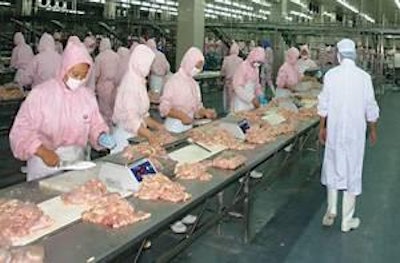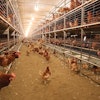
When Springdale, Ark.-based Tyson Foods Inc. started producing chicken in China in the 1990s, the company had only two full production lines and exported all the chickens to Japan.
By 2001, the company was selling fried chicken meat across China. Today, Shandong-based Tyson Dalong Foods Co, Ltd., Tyson’s first Chinese joint venture, sees US$15 in annual sales revenues.
Meanwhile, two new joint ventures – Shandong-based Tyson Xinchang Foods Company, Ltd., and Jiangsu-based Jiangsu Tyson Foods Company, Ltd. – are scheduled to respectively produce 100 million birds and 50 million birds every year, starting in 2010.
“With the help of Tyson’s new plants, Tyson China is expected to increase its annual revenue from about US$15 million now to US$500 million,” Joe Zhu, the market director of Tyson China, told WATT PoultryUSA.
That will make Tyson China the company’s largest international project.
And it’s going to get bigger, added Zhu, “Because China is going to be a major market for meat consumption and will contribute up to 50% of global meat consumption growth in the coming decade.”
Rising poultry market
Dietary changes have followed along with China’s economic development in recent decades. According to the Beijing-based China Meat Association. China’s per capita urban meat consumption increased by 87% from 17 kilos in 1979 to 31.8 kilos in 2007.
Although pork is the favorite source of protein for most Chinese, Tyson China is focusing on the less competitive poultry market – a market which also has more room for growth.
“During the last decade, the growth rate of China’s poultry consumption was faster than that of its pork consumption,” Tyson’s Zhu said. “We have expanded our poultry production in China in order to take advantage of this trend.”
The two Shandong plants – Tyson Dalong and Tyson Xinchang – mainly provide fried chicken and frozen poultry to national foodservice and wholesales channels. Meanwhile, Jiangsu’s Tyson Jiangsu will provide fresh, retail packaged chicken products to the eastern China market (click here to see more information about the plants).
Retail focus
“Although our distribution channels cover foodservice, wholesale and retail sectors, we are trying to sell as much chicken as we can to retailers,” said Zhu.
The retail sector is seeing some major behavior changes, as increasingly wealthy Chinese shoppers flee the unsanitary but traditional outdoor “wet markets” for modern supermarkets, hypermarkets and convenience stores.
“Our market research shows that China’s middle class prefers buying meat in the retail sector, but there is no major poultry supplier,” said Zhu.
In China, most local chicken producers distribute directory to food services companies and other enterprise buyers. There are other foreign producers targeting the retail, including Hormel, but these companies focus on pork.
In order to serve the needs of this rising market, Tyson Jiangsu will distribute small packaged fresh chickens – usually 0.5 kilo to 1 kilo in weight – to retail outlets in eastern China, especially Shanghai.
Furthermore, Tyson China is planning new plants in Guangzhou, Chongqing and Beijing, and will explore the fresh chicken market there, according to Zhu.
Better quality, better returns
The melamine contamination crisis in 2008 exposed China’s severe food safety problems. Foreign companies like Tyson, however, have reputations to maintain and pay close attention to food safety and environmental issues. This helps the company’s image with Chinese consumers, but at a cost.
“As an international company, our biggest advantage is quality control. However, in order to maintain our high standards of quality, we did lose money in China,” said Zhu.
For example, in order to keep its contract with a key customer last year, Tyson China had to match prices offered by local producers – despite higher production costs.
“Even though we suffer in the short term, our high quality products can help us build a good reputation and make more money in the future,” added Zhu.
Banking on technology, processes
The company is also building a reputation on its technology and processes. It’s important to stay ahead of Chinese competitors who can copy products quickly, and then compete with lower prices.
For example, during processing, most local producers hang chicken by their necks, but Tyson Jiangsu hangs chicken by their feet. In this way, Tyson Jinghai can drain more blood out and keep meat fresher for a longer time, according to Zhu.
“With the help of the latest U.S. chicken processing equipment, Tyson Jiangsu will be the most modern chicken processing facility in China,” said Zhu. “It is hard for our competitors to come with the same type of product without using this expensive equipment. So we can keep other producers out of this business and benefit from less competition.”
Adherence to international standards
Another advantage that Tyson has over local competitors is the independence of its safety inspectors.
“Tyson China’s quality control managers are not allowed to be involved in sales and have to report directly to our U.S. company. As a result, all the local plants have to maintain international standards,” Zhu said.
Another independent Tyson team is the Environment, Health and Safety department (EHS).
“We always joke that under EHS’s strict requirements, the wastewater we emit is cleaner than the water which we bring in,” Zhu said.
Like Tyson China’s quality control department, the EHS is not involved in the company’s sales results and has the authority to shut down plant operations.

















